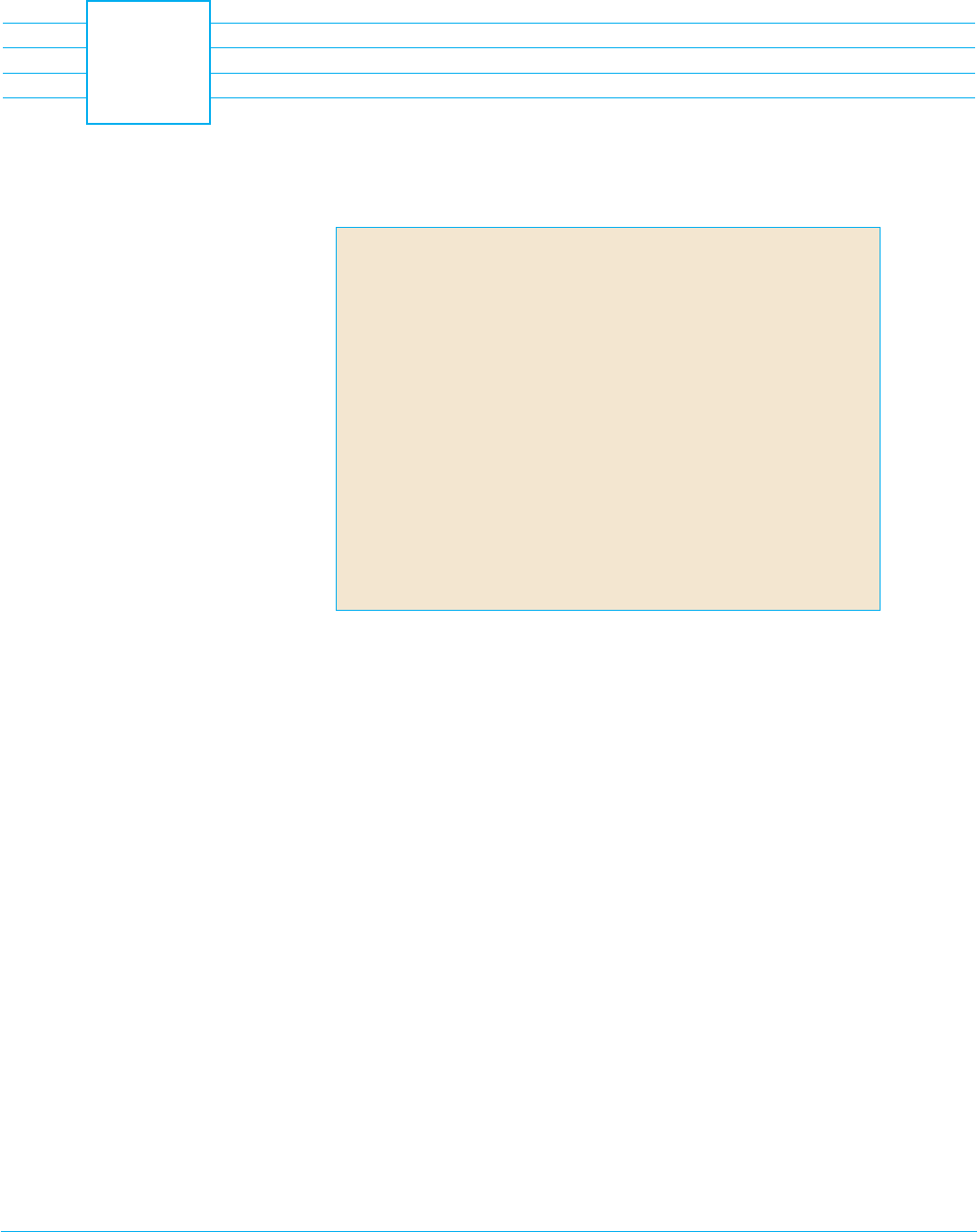Stewart J. Calculus
Подождите немного. Документ загружается.


In general, the even coefficients are given by
and the odd coefficients are given by
The solution is
or
M
In Example 2 we had to assume that the differential equation had a series solu-
tion. But now we could verify directly that the function given by Equation 8 is indeed a
solution.
Unlike the situation of Example 1, the power series that arise in the solution of
Example 2 do not define elementary functions. The functions
and y
2
共x兲 苷 x ⫹
兺
⬁
n苷1
1 ⴢ 5 ⴢ 9 ⴢ ⭈⭈⭈ ⴢ 共4n ⫺ 3兲
共2n ⫹ 1兲!
x
2n⫹1
y
1
共x兲 苷 1 ⫺
1
2!
x
2
⫺
兺
⬁
n苷2
3 ⴢ 7 ⴢ ⭈⭈⭈ ⴢ 共4n ⫺ 5兲
共2n兲!
x
2n
NOTE 3
NOTE 2
苷 ⫹ c
1
冉
x ⫹
兺
⬁
n苷1
1 ⴢ 5 ⴢ 9 ⴢ ⭈⭈⭈ ⴢ 共4n ⫺ 3兲
共2n ⫹ 1兲!
x
2n⫹1
冊
y 苷 c
0
冉
1 ⫺
1
2!
x
2
⫺
兺
⬁
n苷2
3 ⴢ 7 ⴢ ⭈⭈⭈ ⴢ 共4n ⫺ 5兲
共2n兲!
x
2n
冊
8
苷 ⫹ c
1
冉
x ⫹
1
3!
x
3
⫹
1 ⴢ 5
5!
x
5
⫹
1 ⴢ 5 ⴢ 9
7!
x
7
⫹
1 ⴢ 5 ⴢ 9 ⴢ 13
9!
x
9
⫹⭈⭈⭈
冊
苷 c
0
冉
1 ⫺
1
2!
x
2
⫺
3
4!
x
4
⫺
3 ⴢ 7
6!
x
6
⫺
3 ⴢ 7 ⴢ 11
8!
x
8
⫺⭈⭈⭈
冊
y 苷 c
0
⫹ c
1
x ⫹ c
2
x
2
⫹ c
3
x
3
⫹ c
4
x
4
⫹⭈⭈⭈
c
2n⫹1
苷
1 ⴢ 5 ⴢ 9 ⴢ ⭈⭈⭈ ⴢ 共4n ⫺ 3兲
共2n ⫹ 1兲!
c
1
c
2n
苷 ⫺
3 ⴢ 7 ⴢ 11 ⴢ ⭈⭈⭈ ⴢ 共4n ⫺ 5兲
共2n兲!
c
0
Put n 苷 7: c
9
苷
13
8 ⴢ 9
c
7
苷
1 ⴢ 5 ⴢ 9 ⴢ 13
9!
c
1
Put n 苷 6: c
8
苷
11
7 ⴢ 8
c
6
苷 ⫺
3 ⴢ 7 ⴢ 11
8!
c
0
Put n 苷 5: c
7
苷
9
6 ⴢ 7
c
5
苷
1 ⴢ 5 ⴢ 9
5! 6 ⴢ 7
c
1
苷
1 ⴢ 5 ⴢ 9
7!
c
1
Put n 苷 4: c
6
苷
7
5 ⴢ 6
c
4
苷 ⫺
3 ⴢ 7
4! 5 ⴢ 6
c
0
苷 ⫺
3 ⴢ 7
6!
c
0
1172
||||
CHAPTER 18 SECOND-ORDER DIFFERENTIAL EQUATIONS

are perfectly good functions but they can’t be expressed in terms of familiar functions. We
can use these power series expressions for and to compute approximate values of the
functions and even to graph them. Figure 1 shows the first few partial sums
(Taylor polynomials) for , and we see how they converge to . In this way we can
graph both and in Figure 2.
If we were asked to solve the initial-value problem
we would observe from Theorem 12.10.5 that
This would simplify the calculations in Example 2, since all of the even coefficients would
be 0. The solution to the initial-value problem is
y共x兲 苷 x ⫹
兺
⬁
n苷1
1 ⴢ 5 ⴢ 9 ⴢ ⭈⭈⭈ ⴢ 共4n ⫺ 3兲
共2n ⫹ 1兲!
x
2n⫹1
c
1
苷 y⬘共0兲 苷 1c
0
苷 y共0兲 苷 0
y⬘共0兲 苷 1y共0兲 苷 0y⬙⫺2xy⬘⫹y 苷 0
NOTE 4
y
2
y
1
y
1
y
1
共x兲
T
0
, T
2
, T
4
, ...
y
2
y
1
CHAPTER 18 REVIEW
||||
1173
11. ,,
12. The solution of the initial-value problem
is called a Bessel function of order 0.
(a) Solve the initial-value problem to find a power series
expansion for the Bessel function.
;
(b) Graph several Taylor polynomials until you reach one that
looks like a good approximation to the Bessel function on
the interval .关⫺5, 5兴
y⬘共0兲 苷 0y共0兲 苷 1x
2
y⬙⫹xy⬘⫹x
2
y 苷 0
y⬘共0兲 苷 1y共0兲 苷 0y⬙⫹x
2
y⬘⫹xy 苷 0
1–11 Use power series to solve the differential equation.
1. 2.
4.
5. 6.
7.
8.
,,
10. ,,y⬘共0兲 苷 0y共0兲 苷 1y⬙⫹x
2
y 苷 0
y⬘共0兲 苷 0y共0兲 苷 1y⬙⫺xy⬘⫺y 苷 0
9.
y⬙ 苷 xy
共x ⫺ 1兲y⬙⫹y⬘ 苷 0
y⬙ 苷 yy⬙⫹xy⬘⫹y 苷 0
共x ⫺ 3兲y⬘⫹2y 苷 0y⬘ 苷 x
2
y
3.
y⬘ 苷 xyy⬘⫺y 苷 0
EXERCISES
18.4
15
_15
_2.5 2.5
›
fi
FIGURE 1
2
_8
_2
2
T¸
T¡¸
FIGURE 2
REVIEW
CONCEPT CHECK
18
(b) What is the complementary equation? How does it help
solve the original differential equation?
(c) Explain how the method of undetermined coefficients
works.
(d) Explain how the method of variation of parameters works.
4. Discuss two applications of second-order linear differential
equations.
5. How do you use power series to solve a differential equation?
1. (a) Write the general form of a second-order homogeneous
linear differential equation with constant coefficients.
(b) Write the auxiliary equation.
(c) How do you use the roots of the auxiliary equation to solve
the differential equation? Write the form of the solution for
each of the three cases that can occur.
2. (a) What is an initial-value problem for a second-order differ-
ential equation?
(b) What is a boundary-value problem for such an equation?
3. (a) Write the general form of a second-order nonhomogeneous
linear differential equation with constant coefficients.

Determine whether the statement is true or false. If it is true, explain why.
If it is false, explain why or give an example that disproves the statement.
1. If and are solutions of , then is also
a solution of the equation.
2. If and are solutions of , then
is also a solution of the equation.c
1
y
1
⫹ c
2
y
2
y⬙⫹6y⬘⫹5y 苷 xy
2
y
1
y
1
⫹ y
2
y⬙⫹y 苷 0y
2
y
1
3. The general solution of can be written as
4. The equation has a particular solution of the form
y
p
苷 Ae
x
y⬙⫺y 苷 e
x
y 苷 c
1
cosh x ⫹ c
2
sinh x
y⬙⫺y 苷 0
TRUE-FALSE QUIZ
1–10 Solve the differential equation.
1.
2.
3.
4.
5.
6.
7.
8.
9.
10.
,
11–14 Solve the initial-value problem.
11. ,,
12. ,,
13. ,,
14. ,,
15. Use power series to solve the initial-value problem
y⬘共0兲 苷 1y共0兲 苷 0y⬙⫹xy⬘⫹y 苷 0
y⬘共0兲 苷 2y共0兲 苷 19y⬙⫹y 苷 3x ⫹ e
⫺x
y⬘共0兲 苷 1y共0兲 苷 0y⬙⫺5y⬘⫹4y 苷 0
y⬘共0兲 苷 1y共0兲 苷 2y⬙⫺6y⬘⫹25y 苷 0
y⬘共1兲 苷 12y共1兲 苷 3y⬙⫹6y⬘ 苷 0
0
⬍
x
⬍
兾2
d
2
y
dx
2
⫹ y 苷 csc x
d
2
y
dx
2
⫺
dy
dx
⫺ 6y 苷 1 ⫹ e
⫺2x
d
2
y
dx
2
⫹ 4y 苷 sin 2x
d
2
y
dx
2
⫺ 2
dy
dx
⫹ y 苷 x cos x
d
2
y
dx
2
⫹
dy
dx
⫺ 2y 苷 x
2
d
2
y
dx
2
⫺ 4
dy
dx
⫹ 5y 苷 e
2x
4y⬙⫹4y⬘⫹y 苷 0
y⬙⫹3y 苷 0
y⬙⫹4y⬘⫹13y 苷 0
y⬙⫺2y⬘⫺15y 苷 0
16. Use power series to solve the equation
17. A series circuit contains a resistor with , an inductor
with H, a capacitor with F, and a 12-V bat-
tery. The initial charge is C and the initial current
is 0. Find the charge at time t.
18. A spring with a mass of 2 kg has damping constant 16, and a
force of N keeps the spring stretched m beyond its
natural length. Find the position of the mass at time if it
starts at the equilibrium position with a velocity of m兾s.
19. Assume that the earth is a solid sphere of uniform density with
mass and radius mi. For a particle of mass
within the earth at a distance from the earth’s center, the
gravitational force attracting the particle to the center is
where is the gravitational constant and is the mass of the
earth within the sphere of radius .
(a) Show that .
(b) Suppose a hole is drilled through the earth along a diame-
ter. Show that if a particle of mass is dropped from rest
at the surface, into the hole, then the distance of
the particle from the center of the earth at time is given by
where .
(c) Conclude from part (b) that the particle undergoes simple
harmonic motion. Find the period T.
(d) With what speed does the particle pass through the center
of the earth?
k
2
苷 GM兾R
3
苷 t兾R
y⬙共t兲 苷 ⫺k
2
y共t兲
t
y 苷 y共t兲
m
F
r
苷
⫺GMm
R
3
r
r
M
r
G
F
r
苷
⫺GM
r
m
r
2
r
mR 苷 3960M
2.4
t
0.212.8
Q 苷 0.01
C 苷 0.0025L 苷 2
⍀R 苷 40
y⬙⫺xy⬘⫺2y 苷 0
EXERCISES
1174
||||
CHAPTER 18 SECOND-ORDER DIFFERENTIAL EQUATIONS

A1
APPENDIXES
A Numbers, Inequalities, and Absolute Values
B Coordinate Geometry and Lines
C Graphs of Second-Degree Equations
D Trigonometry
E Sigma Notation
F Proofs of Theorems
G Complex Numbers
H Answers to Odd-Numbered Exercises

NUMBERS, INEQUALITIES, AND ABSOLUTE VALUES
Calculus is based on the real number system. We start with the integers:
Then we construct the rational numbers, which are ratios of integers. Thus any rational
number can be expressed as
Examples are
(
Recall that division by is always ruled out, so expressions like and are undefined.
)
Some real numbers, such as , can’t be expressed as a ratio of integers and are therefore
called irrational numbers. It can be shown, with varying degrees of difficulty, that the fol-
lowing are also irrational numbers:
The set of all real numbers is usually denoted by the symbol . When we use the word
number without qualification, we mean “real number.”
Every number has a decimal representation. If the number is rational, then the corre-
sponding decimal is repeating. For example,
(The bar indicates that the sequence of digits repeats forever.) On the other hand, if the
number is irrational, the decimal is nonrepeating:
If we stop the decimal expansion of any number at a certain place, we get an approxima-
tion to the number. For instance, we can write
where the symbol is read “is approximately equal to.” The more decimal places we
retain, the better the approximation we get.
The real numbers can be represented by points on a line as in Figure 1. The positive
direction (to the right) is indicated by an arrow. We choose an arbitrary reference point ,
called the origin, which corresponds to the real number . Given any convenient unit of
measurement, each positive number is represented by the point on the line a distance of
units to the right of the origin, and each negative number is represented by the point
units to the left of the origin. Thus every real number is represented by a point on the
line, and every point on the line corresponds to exactly one real number. The number
associated with the point is called the coordinate of and the line is then called a coor-PP
P
x
⫺xx
x
0
O
⬇
⬇ 3.14159265
苷 3.141592653589793...
s
2
苷 1.414213562373095...
157
495
苷 0.317171717...苷 0.317
9
7
苷 1.285714285714...苷 1.285714
1
2
苷 0.5000...苷 0.50
2
3
苷 0.66666...苷 0.6
⺢
log
10
2sin 1⬚
s
3
2
s
5
s
3
s
2
0
0
3
0
0
0.17 苷
17
100
46 苷
46
1
⫺
3
7
1
2
where m and n are integers and n 苷 0r 苷
m
n
r
..., ⫺3, ⫺2, ⫺1, 0, 1, 2, 3, 4, . . .
A
A2
||||
APPENDIX A NUMBERS, INEQUALITIES, AND ABSOLUTE VALUES

dinate line, or a real number line, or simply a real line. Often we identify the point with
its coordinate and think of a number as being a point on the real line.
The real numbers are ordered. We say is less than and write if is a pos-
itive number. Geometrically this means that lies to the left of on the number line.
(Equivalently, we say is greater than and write .) The symbol (or )
means that either or and is read “ is less than or equal to .” For instance,
the following are true inequalities:
In what follows we need to use set notation. A set is a collection of objects, and these
objects are called the elements of the set. If is a set, the notation means that is
an element of , and means that is not an element of . For example, if repre-
sents the set of integers, then but . If and are sets, then their union
is the set consisting of all elements that are in or (or in both and ). The inter-
section of and is the set consisting of all elements that are in both and . In
other words, is the common part of and . The empty set, denoted by ∅, is the set
that contains no element.
Some sets can be described by listing their elements between braces. For instance, the
set consisting of all positive integers less than 7 can be written as
We could also write in set-builder notation as
which is read “ is the set of such that is an integer and .”
INTERVALS
Certain sets of real numbers, called intervals, occur frequently in calculus and correspond
geometrically to line segments. For example, if , the open interval from to con-
sists of all numbers between and and is denoted by the symbol . Using set-builder
notation, we can write
Notice that the endpoints of the interval—namely, and —are excluded. This is indicated
by the round brackets and by the open dots in Figure 2. The closed interval from to
is the set
Here the endpoints of the interval are included. This is indicated by the square brackets
and by the solid dots in Figure 3. It is also possible to include only one endpoint in an inter-
val, as shown in Table 1.
关 兴
关a, b兴 苷 兵x
ⱍ
a 艋 x 艋 b其
b
a共 兲
ba
共a, b兲 苷 兵x
ⱍ
a
⬍
x
⬍
b其
共a, b兲ba
baa
⬍
b
0
⬍
x
⬍
7xxA
A 苷 兵x
ⱍ
x is an integer and 0
⬍
x
⬍
7其
A
A 苷 兵1, 2, 3, 4, 5, 6其
A
TSS 傽 T
TSS 傽 TTS
TSTSS 傼 T
TS
僆 Z⫺3 僆 Z
ZSaa 僆 SS
aa 僆 SS
2 艋 2
s
2
艋 2
s
2
⬍
2⫺3 ⬎⫺
7
⬍
7.4
⬍
7.5
baa 苷 ba
⬍
b
b 艌 aa 艋 bb ⬎ aab
ba
b ⫺ aa
⬍
bba
FIGURE 1
0
1234_1_2_3
_2.63
2
π
_
œ
„
1
2
3
7
APPENDIX A NUMBERS, INEQUALITIES, AND ABSOLUTE VALUES
||||
A3
FIGURE 2
Open interval (a,b)
ab
FIGURE 3
Closed interval [a,b]
a b

TABLE OF INTERVALS
We also need to consider infinite intervals such as
This does not mean that (“infinity”) is a number. The notation stands for the set
of all numbers that are greater than , so the symbol simply indicates that the interval
extends indefinitely far in the positive direction.
INEQUALITIES
When working with inequalities, note the following rules.
RULES FOR INEQUALITIES
1.
If , then .
2. If and , then .
3. If and , then .
4. If and , then .
5. If , then .
Rule 1 says that we can add any number to both sides of an inequality, and Rule 2 says
that two inequalities can be added. However, we have to be careful with multiplication.
Rule 3 says that we can multiply both sides of an inequality by a positive number, but
|
Rule 4 says that if we multiply both sides of an inequality by a negative number, then we
reverse the direction of the inequality. For example, if we take the inequality and
multiply by , we get , but if we multiply by , we get . Finally, Rule 5
says that if we take reciprocals, then we reverse the direction of an inequality (provided
the numbers are positive).
EXAMPLE 1 Solve the inequality .
SOLUTION The given inequality is satisfied by some values of but not by others. To solve
an inequality means to determine the set of numbers for which the inequality is true.
This is called the solution set.
x
x
1 ⫹ x
⬍
7x ⫹ 5
⫺6 ⬎⫺10⫺26
⬍
102
3
⬍
5
1兾a ⬎ 1兾b0
⬍
a
⬍
b
ac ⬎ bcc
⬍
0a
⬍
b
ac
⬍
bcc ⬎ 0a
⬍
b
a ⫹ c
⬍
b ⫹ dc
⬍
da
⬍
b
a ⫹ c
⬍
b ⫹ ca
⬍
b
2
⬁a
共a, ⬁兲⬁
共a, ⬁兲 苷 兵x
ⱍ
x ⬎ a其
1
A4
||||
APPENDIX A NUMBERS, INEQUALITIES, AND ABSOLUTE VALUES
Notation Set description Picture
(set of all real numbers)⺢共⫺⬁, ⬁兲
兵x
ⱍ
x 艋 b其共⫺⬁, b兴
兵x
ⱍ
x
⬍
b其共⫺⬁, b兲
兵x
ⱍ
x 艌 a其关a, ⬁兲
兵x
ⱍ
x ⬎ a其共a, ⬁兲
兵x
ⱍ
a
⬍
x 艋 b其共a, b兴
兵x
ⱍ
a 艋 x
⬍
b其关a, b兲
兵x
ⱍ
a 艋 x 艋 b其关a, b兴
兵x
ⱍ
a
⬍
x
⬍
b其共a, b兲
N Table 1 lists the nine possible types of inter-
vals. When these intervals are discussed, it is
always assumed that .a
⬍
b
ab
ab
ab
ab
a
a
b
b

First we subtract 1 from each side of the inequality (using Rule 1 with ):
Then we subtract from both sides (Rule 1 with ):
Now we divide both sides by
(
Rule 4 with
)
:
These steps can all be reversed, so the solution set consists of all numbers greater than
. In other words, the solution of the inequality is the interval . M
EXAMPLE 2 Solve the inequalities .
SOLUTION Here the solution set consists of all values of that satisfy both inequalities.
Using the rules given in (2), we see that the following inequalities are equivalent:
(add 2)
(divide by 3)
Therefore the solution set is . M
EXAMPLE 3 Solve the inequality .
SOLUTION First we factor the left side:
We know that the corresponding equation has the solutions 2 and 3.
The numbers 2 and 3 divide the real line into three intervals:
On each of these intervals we determine the signs of the factors. For instance,
Then we record these signs in the following chart:
Another method for obtaining the information in the chart is to use test values. For
instance, if we use the test value for the interval , then substitution in
gives
1
2
⫺ 5共1兲 ⫹ 6 苷 2
x
2
⫺ 5x ⫹ 6
共⫺⬁, 2兲x 苷 1
x ⫺ 2
⬍
0 ? x
⬍
2 ? x 僆 共⫺⬁, 2兲
共3, ⬁兲共2, 3兲共⫺⬁, 2兲
共x ⫺ 2兲共x ⫺ 3兲 苷 0
共x ⫺ 2兲共x ⫺ 3兲 艋 0
x
2
⫺ 5x ⫹ 6 艋 0
关2, 5兲
2 艋 x
⬍
5
6 艋 3x
⬍
15
4 艋 3x ⫺ 2
⬍
13
x
4 艋 3x ⫺ 2
⬍
13
(
⫺
2
3
, ⬁
)
⫺
2
3
x ⬎⫺
4
6
苷 ⫺
2
3
c 苷 ⫺
1
6
⫺6
⫺6x
⬍
4
c 苷 ⫺7x7x
x
⬍
7x ⫹ 4
c 苷 ⫺1
APPENDIX A NUMBERS, INEQUALITIES, AND ABSOLUTE VALUES
||||
A5
FIGURE 4
x
0
y
y=≈-5x+6
1
234
N A visual method for solving Example 3 is to
use a graphing device to graph the parabola
(as in Figure 4) and observe
that the curve lies on or below the -axis when
.2 艋 x 艋 3
x
y 苷 x
2
⫺ 5x ⫹ 6
Interval
⫺⫺ ⫹
⫹⫺ ⫺
⫹⫹ ⫹ x ⬎ 3
2
⬍
x
⬍
3
x
⬍
2
共x ⫺ 2兲共x ⫺ 3兲x ⫺ 3x ⫺ 2

The polynomial doesn’t change sign inside any of the three intervals, so we
conclude that it is positive on .
Then we read from the chart that is negative when . Thus
the solution of the inequality is
Notice that we have included the endpoints 2 and 3 because we are looking for values of
such that the product is either negative or zero. The solution is illustrated in Figure 5. M
EXAMPLE 4 Solve .
SOLUTION First we take all nonzero terms to one side of the inequality sign and factor the
resulting expression:
As in Example 3 we solve the corresponding equation and use the
solutions , , and to divide the real line into four intervals ,
, , and . On each interval the product keeps a constant sign as shown
in the following chart:
Then we read from the chart that the solution set is
The solution is illustrated in Figure 6.
M
ABSOLUTE VALUE
The absolute value of a number , denoted by , is the distance from to on the real
number line. Distances are always positive or , so we have
For example,
In general, we have
ⱍ
a
ⱍ
苷 ⫺a if a
⬍
0
ⱍ
a
ⱍ
苷 a if a 艌 0
3
ⱍ
3 ⫺
ⱍ
苷
⫺ 3
ⱍ
s
2
⫺ 1
ⱍ
苷
s
2
⫺ 1
ⱍ
0
ⱍ
苷 0
ⱍ
⫺3
ⱍ
苷 3
ⱍ
3
ⱍ
苷 3
for every number a
ⱍ
a
ⱍ
艌 0
0
0a
ⱍ
a
ⱍ
a
兵x
ⱍ
⫺4
⬍
x
⬍
0 or x ⬎ 1其 苷 共⫺4, 0兲 傼 共1, ⬁兲
共1, ⬁兲共0, 1兲共⫺4, 0兲
共⫺⬁, ⫺4兲x 苷 1x 苷 0x 苷 ⫺4
x共x ⫺ 1兲共x ⫹ 4兲 苷 0
x共x ⫺ 1兲共x ⫹ 4兲 ⬎ 0 orx
3
⫹ 3x
2
⫺ 4x ⬎ 0
x
3
⫹ 3x
2
⬎ 4x
x
兵x
ⱍ
2 艋 x 艋 3其 苷 关2, 3兴
共x ⫺ 2兲共x ⫺ 3兲 艋 0
2
⬍
x
⬍
3共x ⫺ 2兲共x ⫺ 3兲
共⫺⬁, 2兲
x
2
⫺ 5x ⫹ 6
A6
||||
APPENDIX A NUMBERS, INEQUALITIES, AND ABSOLUTE VALUES
023
+
-+
FIGURE 5
x
Interval x
⫺⫺ ⫺ ⫺
⫺⫺ ⫹ ⫹
⫹⫺ ⫹ ⫺
⫹⫹ ⫹ ⫹ x ⬎ 1
0
⬍
x
⬍
1
⫺4
⬍
x
⬍
0
x
⬍
⫺4
x共x ⫺ 1兲共x ⫹ 4兲x ⫹ 4x ⫺ 1
01
_4
FIGURE 6
N Remember that if is negative, then
is positive.
⫺aa

APPENDIX A NUMBERS, INEQUALITIES, AND ABSOLUTE VALUES
||||
A7
0
a
_a
x
a a
|x|
FIGURE 7
|a-b|
ab
|a-b|
ba
FIGURE 8
Length of a line segment=|a-b|
EXAMPLE 5 Express without using the absolute-value symbol.
SOLUTION
M
Recall that the symbol means “the positive square root of.” Thus means
|
and . Therefore, the equation is not always true. It is true only when
. If , then , so we have . In view of (3), we then have the
equation
which is true for all values of .
Hints for the proofs of the following properties are given in the exercises.
PROPERTIES OF ABSOLUTE VALUES Suppose and are any real numbers and
is an integer. Then
1. 2. 3.
For solving equations or inequalities involving absolute values, it’s often very helpful
to use the following statements.
Suppose . Then
4. if and only if
5. if and only if
6. if and only if or
For instance, the inequality says that the distance from to the origin is less
than , and you can see from Figure 7 that this is true if and only if lies between and .
If and are any real numbers, then the distance between and is the absolute value
of the difference, namely, , which is also equal to . (See Figure 8.)
EXAMPLE 6 Solve .
SOLUTION By Property 4 of (6), is equivalent to
So or . Thus or . Mx 苷 1x 苷 42x 苷 22x 苷 8
2x ⫺ 5 苷 ⫺3or2x ⫺ 5 苷 3
ⱍ
2x ⫺ 5
ⱍ
苷 3
ⱍ
2x ⫺ 5
ⱍ
苷 3
ⱍ
b ⫺ a
ⱍⱍ
a ⫺ b
ⱍ
baba
a⫺axa
x
ⱍ
x
ⱍ
⬍
a
x
⬍
⫺ax ⬎ a
ⱍ
x
ⱍ
⬎ a
⫺a
⬍
x
⬍
a
ⱍ
x
ⱍ
⬍
a
x 苷 ⫾a
ⱍ
x
ⱍ
苷 a
a ⬎ 0
6
ⱍ
a
n
ⱍ
苷
ⱍ
a
ⱍ
n
共b 苷 0兲
冟
a
b
冟
苷
ⱍ
a
ⱍ
ⱍ
b
ⱍ
ⱍ
ab
ⱍ
苷
ⱍ
a
ⱍⱍ
b
ⱍ
n
ba
5
a
s
a
2
苷
ⱍ
a
ⱍ
4
s
a
2
苷 ⫺a⫺a ⬎ 0a
⬍
0a 艌 0
s
a
2
苷 as 艌 0s
2
苷 r
s
r 苷 s
s
1
苷
再
3x ⫺ 2
2 ⫺ 3x
if x 艌
2
3
if x
⬍
2
3
ⱍ
3x ⫺ 2
ⱍ
苷
再
3x ⫺ 2
⫺共3x ⫺ 2兲
if 3x ⫺ 2 艌 0
if 3x ⫺ 2
⬍
0
ⱍ
3x ⫺ 2
ⱍ
